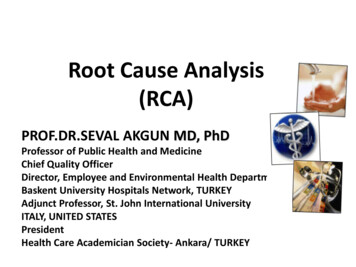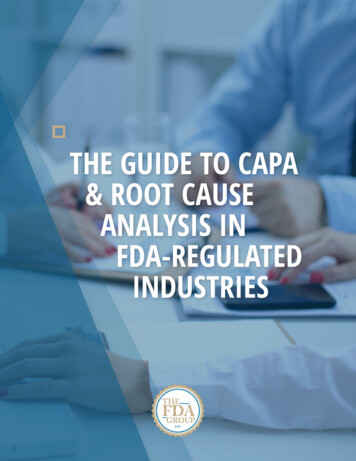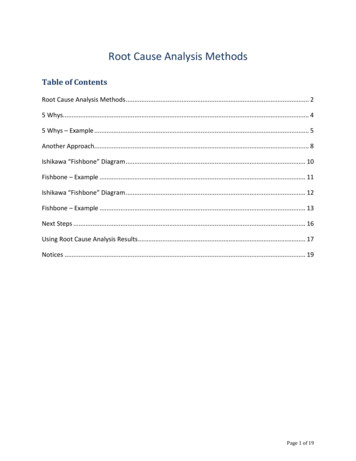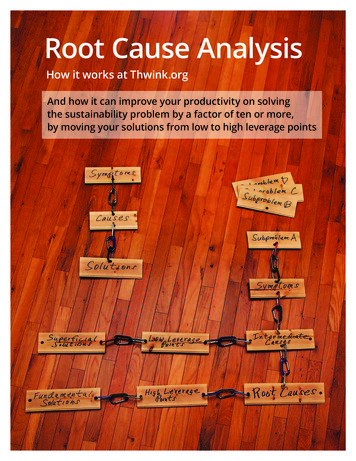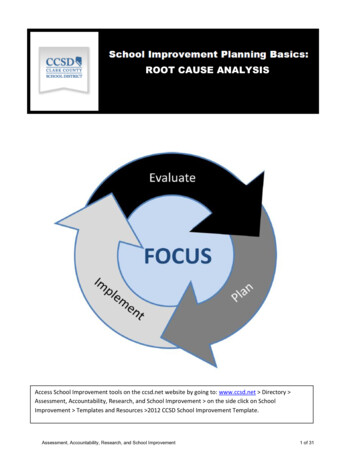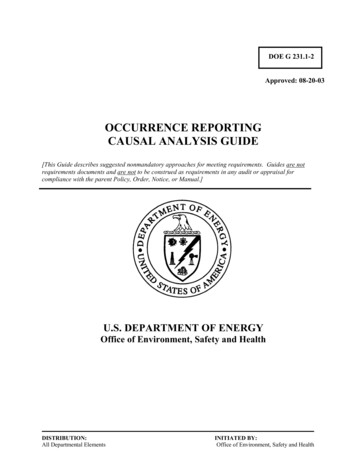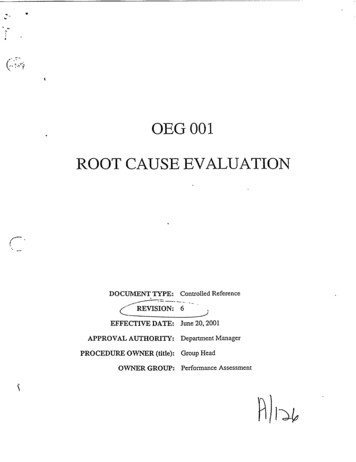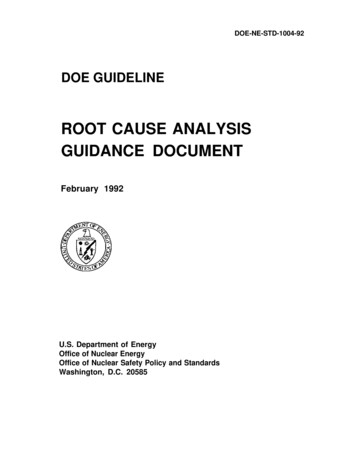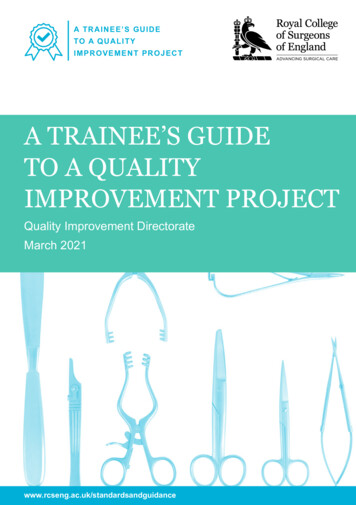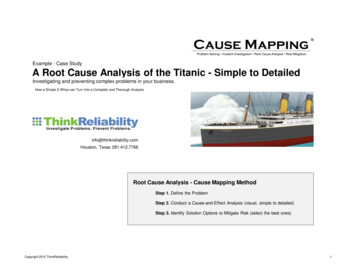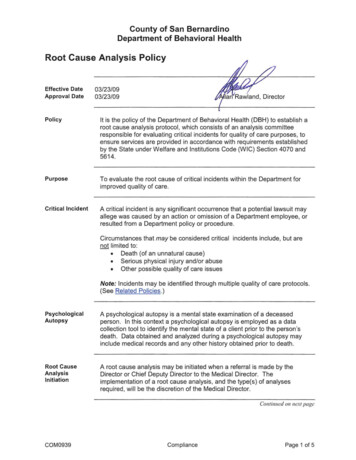
Transcription
County of San BernardinoDepartment of Behavioral HealthRoot Cause Analysis PolicyEffective DateApproval Date03/23/0903/23/09PolicyIt is the policy of the Department of Behavioral Health (DBH) to establish aroot cause analysis protocol, which consists of an analysis committeeresponsible for evaluating critical incidents for quality of care purposes, toensure services are provided in accordance with requirements establishedby the State under Welfare and Institutions Code (WIC) Section 4070 and5614.PurposeTo evaluate the root cause of critical incidents within the Department forimproved quality of care.Critical IncidentA critical incident is any significant occurrence that a potential lawsuit mayallege was caused by an action or omission of a Department employee, orresulted from a Department policy or procedure.Circumstances that may be considered critical incidents include, but arenot limited to: Death (of an unnatural cause) Serious physicai injury andlor abuse Other possible quality of care issuesNote: Incidents may be identified through multiple quality of care protocols.(See Related Policies.)PsychologicalAutopsyRoot CauseAnalysisInitiationA psychological autopsy is a mental state examination of a deceasedperson. In this context a psychological autopsy is employed as a datacollection tool to identify the mental state of a client prior to the person'sdeath. Data obtained and analyzed during a psychological autopsy mayinclude medical records and any other history obtained prior to death.A root cause analysis may be initiated when a referral is made by theDirector or Chief Deputy Director to the Medical Director. Theimpiementation of a root cause anaiysis, and the type(s) of analysesreqUired, will be the discretion of the Medical Director.Comillucd 011 next pageCOM0939CompliancePage 1 of 5
County of San BernardinoDepartment of Behavioral HealthRoot Cause Analysis Policy,Root CauseAnalysisCommitteeContinuedThe Root Cause Analysis Committee is composed of the Medical Director,Compliance Officer, the Deputy Director from the related program, subjectmatter experts (such as a Psychiatrist(s) and other clinical staff), andQuality Management. The Committee will be assembled on a case-bycase basis. A thorough analysis and investigation may require theCommittee to meet on multiple occasions depending on the severity of theincident and involvement required. It is important that all departmentalresources be brought together during the process of conducting the rootcause analysis to obtain all available information, knowledge and expertise.During meetings and on-going collaboration, the Root Cause AnalysisCommittee will: Identify and investigate any actions that violated or may haveviolated State quality assurance requirements Conduct an informed and objective case review Objectively research and analyze critical incidents and significanttrends Analyze Department policies, procedures and general practices Verify and assess compliance with established policies Incorporate the guidance of County Counsel and other subjectmatter experts Identify Departmental practices that may be vulnerable to criticalincidents Identify trends and evaluate specific programs or practices that areconsistently areas of deficiencyAfter the analysis has concluded, the Committee will: Recommend policies and procedures designed to prevent similarincidents Recommend operational and organizational changes to ensure bestpractices and eliminate exposure to liability issues Submit a comprehensive critical incident report to the DirectorComplianceOfficerResponsibilityIt is the responsibility of the Compliance Officer to: Ensure coordination of intradepartmental resources whenconducting a root cause analysis containing compliance relatedmatters Analyze critical incident information and seek legal advise fromCounty CounselCominued all next pngeCOM0939CompliancePage 2 of 5
County of San BernardinoDepartment of Behavioral HealthRoot Cause Analysis rend Analysis ContinuedCommunicate with County Counsel and disseminate information toRoot Cause Analysis TeamInfluence areas of risk management and policy to ensure bestpractices and quality of careA trend analysis refers to the concept of collecting information andattempting to identify a pattern or trend. Trend analysis will be a significantpart of the root cause analysis; it particularly includes identifying trends ofspecific incident types, and/or reoccurring circumstances that may havecontributed to the incident being evaluated. Such reoccurringcircumstances, or states of nature, are considered adverse to theDepartment.A trend analysis will assist in strategically formulating the plan of action tocorrect problem areas. Identifying trends and analyzing causal factorsempower the Root Cause Analysis Committee to make recommendationsand improve the decision making process.Priority LevelCritical incidents for review will be analyzed by priority. Priority levels arelisted as follows:Level1Description/Example 2 DeathPhysical harmA grievance or lawsuit has been filedDesignation by the Medical Director, Chief Deputy Directoror DirectorCivil rights complaint filed in courtViolent or high profile case in courtDepartment error(s) and/or omissions identifiedClaim status onlyAn identifiable or permanent injury without evidence ofDepartment involvementPreliminary review (by the Office of Compliance)establishes low exposure to departmental error or omissionContinued 011 next pageCOM0939CompliancePage 3 of 5
County of San BernardinoDepartment of Behavioral HealthRoot Cause Analysis Policy,Root CauseAnalysis ProcessContinuedThe following illustrates the root cause analysis process:Stage123456DescriptionPreliminary review of Unusual Occurrence/Incident Report orother reporting mechanismAdvisement to Department Director and County Counsel ofinvestigation/analysisPlanning and coordination of the analysis and investigation,including determination of participants for the Root CauseAnalysis CommitteeCommittee meetings and collaboration, which may include: Research of applicable practices, policies, regulations andlaws Consultation with County Counsel regarding liabilityconcerns, legal guidelines and case precedence Utilization of various resources, including, but not limitedto:-Fraud investigators-Human Resource Officer-Risk Management-Civil Rights Investigators-Department Supervisors,Managers and direct service providers-Outside experts (without divulging any information thatmay jeopardize the integrity of the Department)Organizingand implementing a psychological autopsy Follow-up Team meeting and collaboration, which may include: Analysis and discussion of information gathered Identifying and analyzing trends in researched data Outlining recommendations to prevent future criticalincident occurrences and improve program effectiveness(i.e. policies, procedures, and operational and/ororqanizational chanqes)Prepare a comprehensive critical incident report and present tothe Department DirectorNote: The comprehensive critical incident report that is presentedto the Director is generally submitted forty-five (45) days from thetime the initial incident report was received by the Office ofCompliance. However, completion time may vary depending onthe complexity of the analysis and investiqation.COll1inued on next pageCOM0939CompliancePage 4 of 5
Root Cause Analysis Policy, Continued Root Cause Analysis Committee Compliance Officer Responsibility The Root Cause Analysis Committee is composed ofthe Medical Director, Compliance Officer, the Deputy Directorfrom the related program, subject matter experts (such as a Psychiatr

